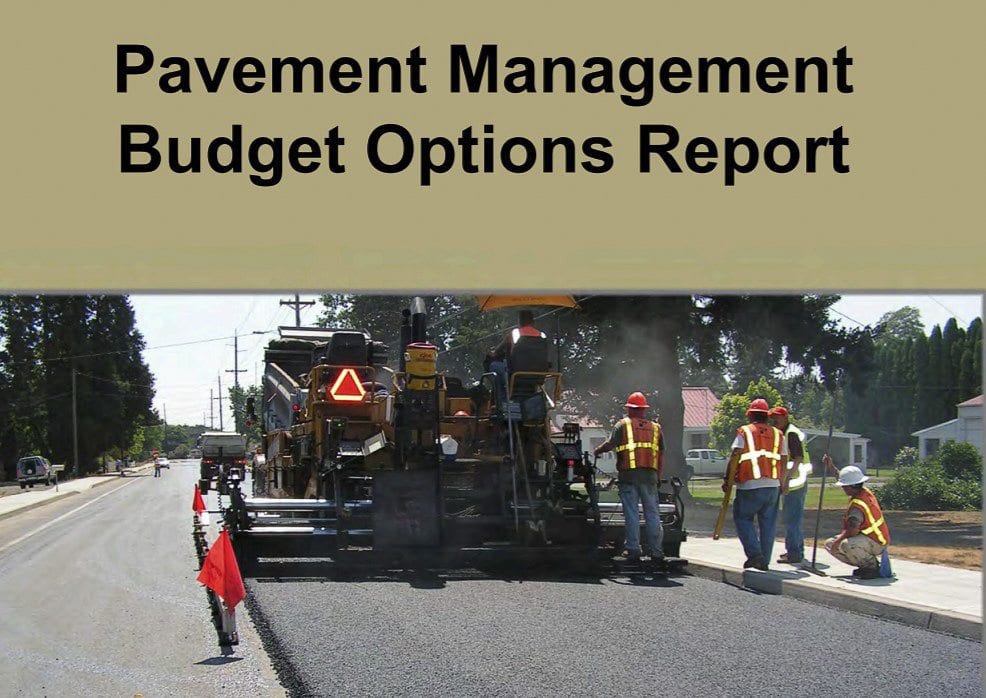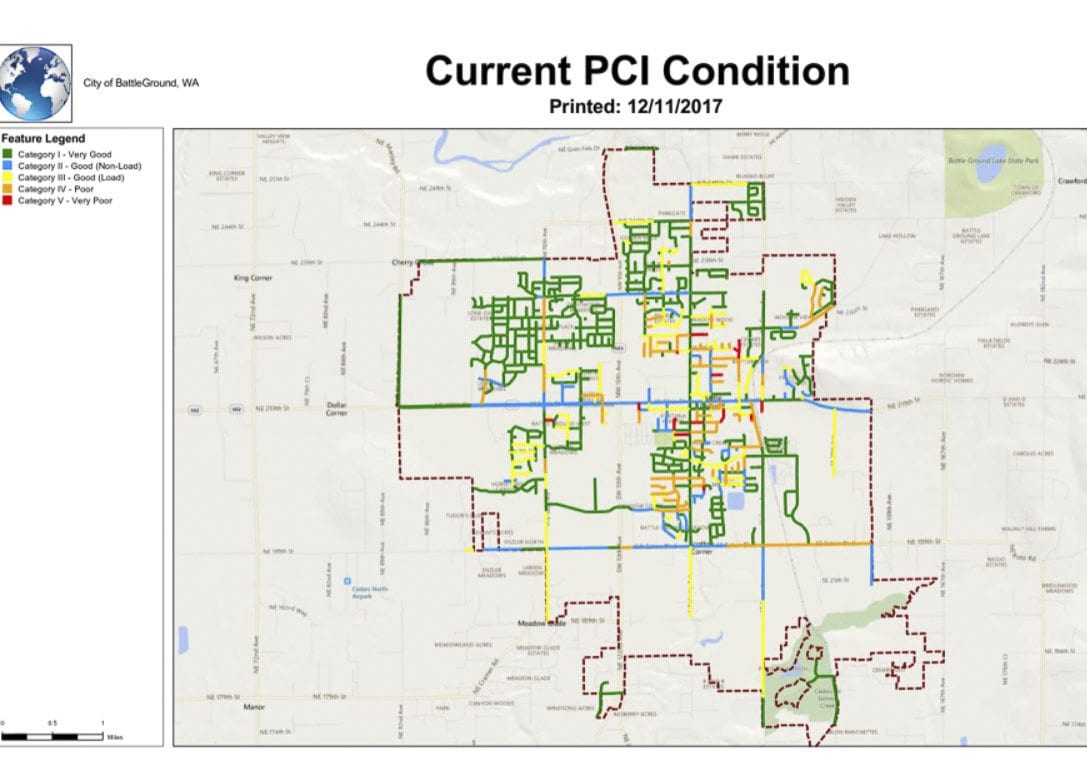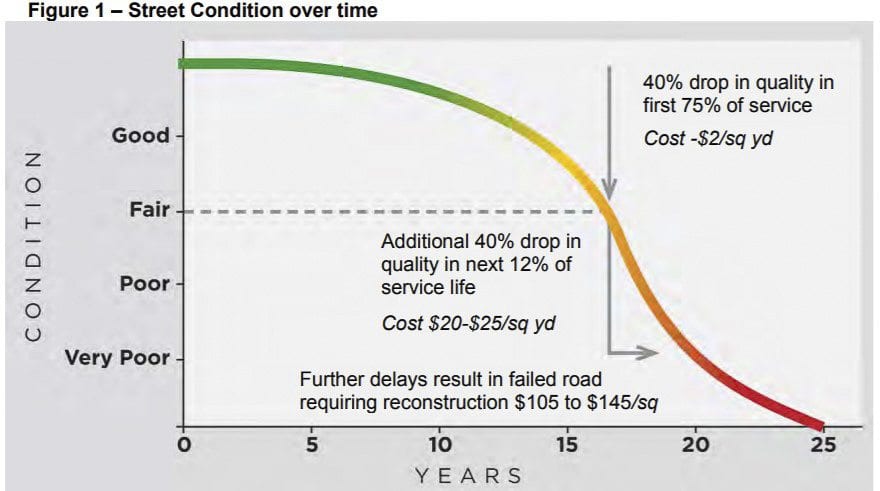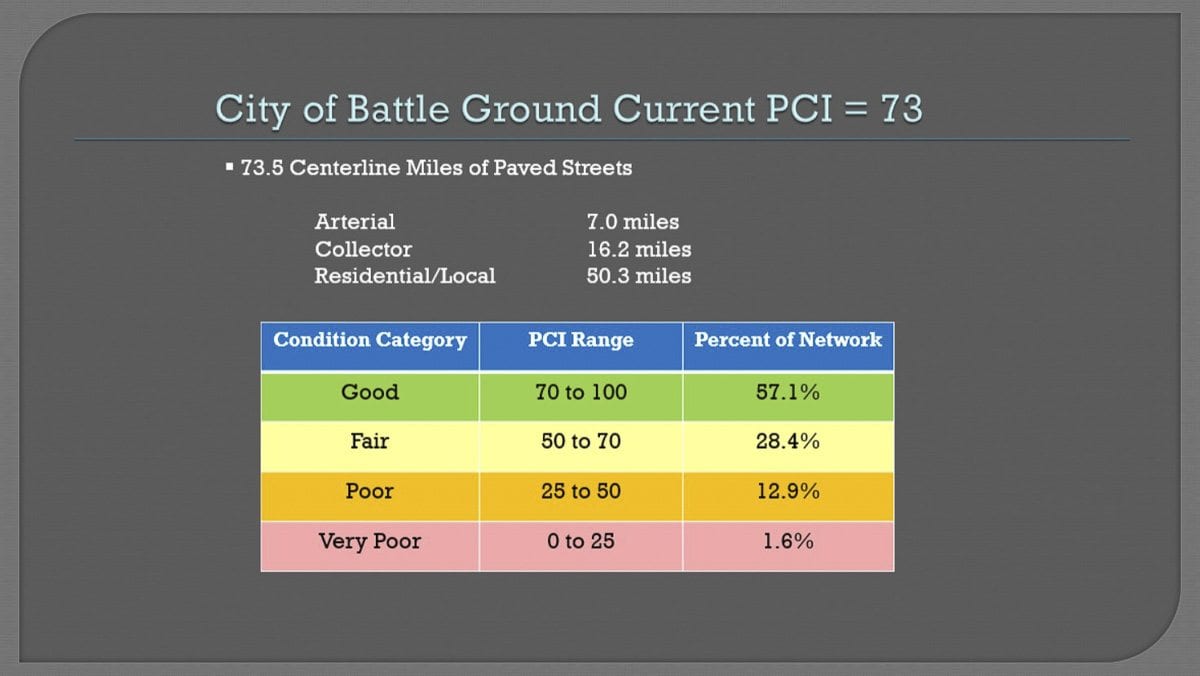City Council heard a report this week detailing what it would cost to keep ahead of deteriorating streets
BATTLE GROUND — The city of Battle Ground has a long road ahead when it comes to getting its streets into shape. At a work session earlier this week, council members heard from city planners what the future looks like if nothing changes, and what it would cost to get ahead of the problem with cracked and deteriorating roads.
Battle Ground is primarily responsible for maintaining nearly 74 miles of roadway. The majority of those are neighborhood streets, rather than feeders or arterials. That means there’s no chance of getting grant money to help pay to fix those up.
The city recently contracted with Capitol Asset and Pavement Services to do a visual inspection of all 73.53 miles of streets within Battle Ground’s purview. Their report found that 57 percent were in good condition, 28 percent were fair, while nearly 15 percent were either poor or very poor.

The report also determined the Pavement Condition Index (PCI) rating for Battle Ground streets was 73. While that’s on par with most other cities in the area, it falls well below a preferred PCI rating in the low-to-mid 80s. That’s in the middle of the “good” category, and considered to be the optimal operational position for street maintenance.
But repairing streets isn’t cheap, especially ones that have been allowed to reach a poor rating. According to the report, the city would need to spend just over $17 million over the next five years to bring streets up to the preferred level, including nearly $7 million in the first year alone. Currently the city has less than $1 million over the next five years set aside for street maintenance.

That funding level, the report says, indicates an outdated way of viewing street repairs, where road surfaces are allowed to deteriorate before repairs are scheduled.
“Under this ‘worst-first’ policy, streets are allowed to deteriorate to a nearly failed condition before any rehabilitation (such as overlays or reconstructions), are applied,” the report says, “This can also be called the ‘don’t fix if it isn’t broke’ mentality.”
Under new policy, the city would prioritize maintaining Good streets, with the rehabilitation of Fair streets coming next, and the repair of Poor streets as the last priority. The idea being that keeping good streets “Good” is a more cost-effective long term policy.
Many cities these days are adopting a more proactive approach, such as slurry seals, chip seals, microsurfacing, and crack seals. Those treatments can greatly extend the life of a road surface, while costing much less. When roads are allowed to deteriorate before repairs are done, the costs go up exponentially.

Under the city’s existing street maintenance budget of $190,000 per year, the analysts predicted that the PCI rating will dip to 65 by 2022, while the cost of deferred maintenance balloons from the current $6.7 million to nearly $15 million. Under that scenario, more than a quarter of Battle Ground streets would likely be rated as Poor or Very Poor within five years, according to the study, up from the current 14.5 percent.
Simply maintaining the existing condition of Battle Ground streets, the report says, would cost $1.1 million dollars per year, and still end up with a deferred maintenance bill of almost $12 million in 2022.
The fourth scenario would budget $1.9 million a year for street repair (10 times the current amount). The report said that could increase the PCI score by five points within five years, while ending up with a deferred maintenance bill of $8.5 million.

The report also made several other recommendations including:
- Link major street repairs with utility maintenance schedules to prevent damage to newly paved street surfaces.
- Obtain detailed subsurface information on selected sections before major rehabilitation projects are contracted. Costs for large rehabilitation projects are extremely variable and estimates can sometimes be reduced following project-level engineering analysis. It is possible that only a portion of a street recommended for reconstruction actually requires such heavy-duty repair.
- Evaluate the specific treatments and costs recommended by the PMP, and modify them to reflect the actual repairs and unit costs that are expected to be used.
- Test other budget options with varying revenues and preventive maintenance and rehabilitation splits.
- Prepare a recommended five-year maintenance program. The program should include the amount of revenues available for pavement repair, a list of streets to be repaired, and the type of repair to be completed (listed in order of year of scheduled treatment), as well as any requests for specific budgetary actions.
The presentation on Monday did not set a timeline for action to be taken, but the public works department is expected to narrow down the options for city council to consider over the coming months. Battle Ground will set its budget for the 2019-2020 cycle this December.




